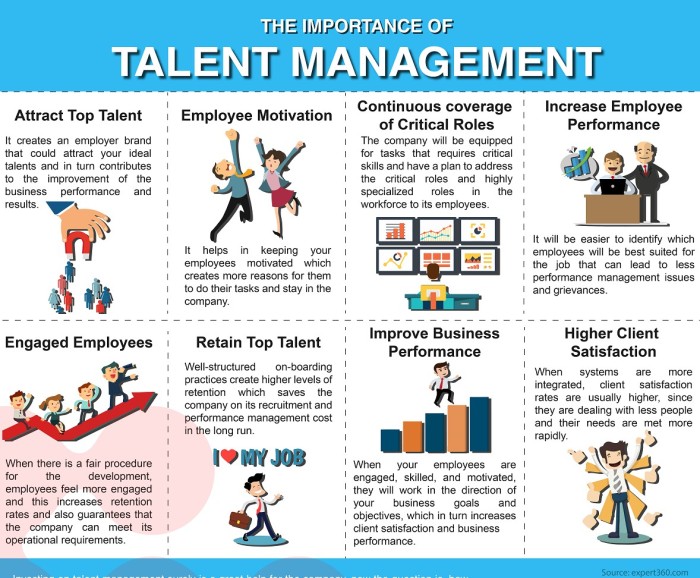
The ability to attract, motivate, develop and retain engaged employees who will be productive in working to assist an organization in reaching its strategic objectives and operational goals is known as talent management. An understanding of talent management processes and the essential tools available to create a highly successful team of individuals should be included in your business or organizational procedures. The tools required for successful talent management include workforce planning, recruiting, strategic plan and goal alignment, executive coaching, leadership development, recognition programs, diversity and inclusion, and engagement, as well as retention. Let’s look closer at how an effective talent management plan will make it easier to identify, recruit, engage and retain talented individuals to be a part of your organization.
Talent Management begins with Workforce Planning
Effective workforce planning involves an intentional strategic goal to access talented individuals from both inside and outside your organization that have the knowledge, skills, and behaviors needed to achieve the demands and objectives set for your organization. Workforce planning should take into account both strategic and operational workforce planning. Strategic workforce planning takes into consideration the strategic needs of an organization and its associated workforce. This includes the projected loss due to employee exits as well as the projected qualification requirements necessary to sustain and progress organizational goals. Operational workforce planning is process based. Operational workforce planning builds on the use of simple tools, and techniques leading to templates and procedures that can then be integrated into your existing workforce base.
Recruiting Effectively
Recruiting involves the ability to successfully identify, attract and hire talented individuals with the potential to move your organization towards accomplishing your objectives. This is accomplished through targeted advertising and focused interviewing of perspective candidates. Consider including a clear mission statement as part of your recruitment advertising. This is likely to attract those with the talent and desire to become a part of your mission to move your organization forward. Clear job descriptions and skills lists further help narrow the field of applicants.
Strategic Plan & Goal Alignment
Having a strategic plan that includes goal alignment may be one of the most important things you can do to maximize the profitability of your organization. A strategic plan and goal alignment ensures everyone is moving forward towards the same goals to optimize resources and achieve the vision for your organization. With a clear strategic plan in place, management can clearly see the strengths and weaknesses at any time and has the flexibility to make changes and adjustments more readily.
Executive Coaching
Executive coaching is a relationship that provides motivation and inspiration to make changes that transform employees and those around them to obtain optimal results personally and professionally. In supporting growth and change both the individual and organization benefits. Ideally, executive coaching helps leaders and those with leadership potential to examine possibilities and transfer their discoveries to move themselves and the organization forward.
Leadership Development
Leadership development involves a plan of goal-driven strategies designed to enhance the leadership attitudes and abilities within an organization or individual. The goal is to develop a team of high quality leaders with the ability to effectively share the vision of the organization as well as inspire and motivate those around them to achieve their best both individually and within the workplace. Leadership development enables top personnel to quickly access potential problems and implement strategies to avoid undue damage or delay to overall goals. An effective leadership program fosters open communication and encourages groups to work cooperatively to achieve personal and organizational excellence.
Recognition Programs
Recognition programs within an organization acknowledge the individuals and teams that consistently contribute to your organization’s success. Setting up an ongoing recognition program that honors, and thanks loyal staff and team members increases overall job satisfaction. Encourage team leaders to acknowledge contributions from individual team members on a regular basis with a word of thanks, or repeating an encouraging comment made by a satisfied customer. Including an unexpected thank you to those working behind the scenes should also be a part of any ongoing recognition programs you develop.
Diversity/ Inclusion
An awareness of diversity and inclusion extends far beyond the internal work. Diversity and inclusion also encompasses customers, suppliers, and other outside resources. In addition to ethnic and cultural differences, there are also generational differences and gender to consider. True diversity must include those both inside and outside your business structure. Diversity and inclusion in a workplace or organization brings many advantages including increased creativity, productivity and problem solving. Enhanced communication and an expanded market share are also real benefits. Inclusion adds value to employees that leads to retention and increases the ability to attract top talent from many resources.
Engagement
Engagement involves encouraging employees to be fully involved and enthusiastic about their workplace with the desire to help move the business ahead. Employee engagement is encouraged in an environment that supports open communication where everyone feels their voice and ideas will be heard. Show your employees they are a valuable part of the team and they are less likely to seek employment elsewhere. A successful plan that encourages employee engagement is seen when employees are motivated to enhance your organization’s success while feeling their own well-being is of importance.
Retention
All organizations know the frustration of investing in the recruiting and training of talented individuals only to have valuable employees move to a potentially better prospect. Employee retention depends on understanding why valuable employees are moving on and how you can prevent them from leaving. Salary, work schedules, comfortable surroundings or the prospect for better advancement are only a few possible reasons to consider. It cost money to recruit, hire and train employees. It is better to keep skilled employees than lose them to a possible competitor. Perks, competitive benefit packages, promoting from within and offering incentives are a few ways to increase employee retainment.

 Follow
Follow